It has not been a happy season for West Ham United Women, with them struggling to pick up points in the WSL, and currently finding themselves sitting second-bottom of the league, only two points above bottom club Bristol City Women. They have made a managerial change, as former Liverpool Women boss Matt Beard left the club in November and was replaced by Olli Harder, with the New Zealander joining from Norwegian men’s club Sandnes Ulf, where he had been assistant manager. However, they are not yet certain of survival, and know they need to pick up more points if they want to ensure safety in the women’s top flight for another season.
In this tactical analysis, we will look at West Ham’s tactics, with particular focus on where they are stronger, and where they can improve, giving them a good chance of staying up. To do this, the scout report will look at four different aspects of the team.
The midfielders’ free roles
The first thing we will look at is how the West Ham United Women midfielders have a free role in the team. Canada international Adriana Leon and Australia midfielder Emily van Egmond in particular like to drift around the pitch, moving into spaces where they can offer something for the rest of the team.
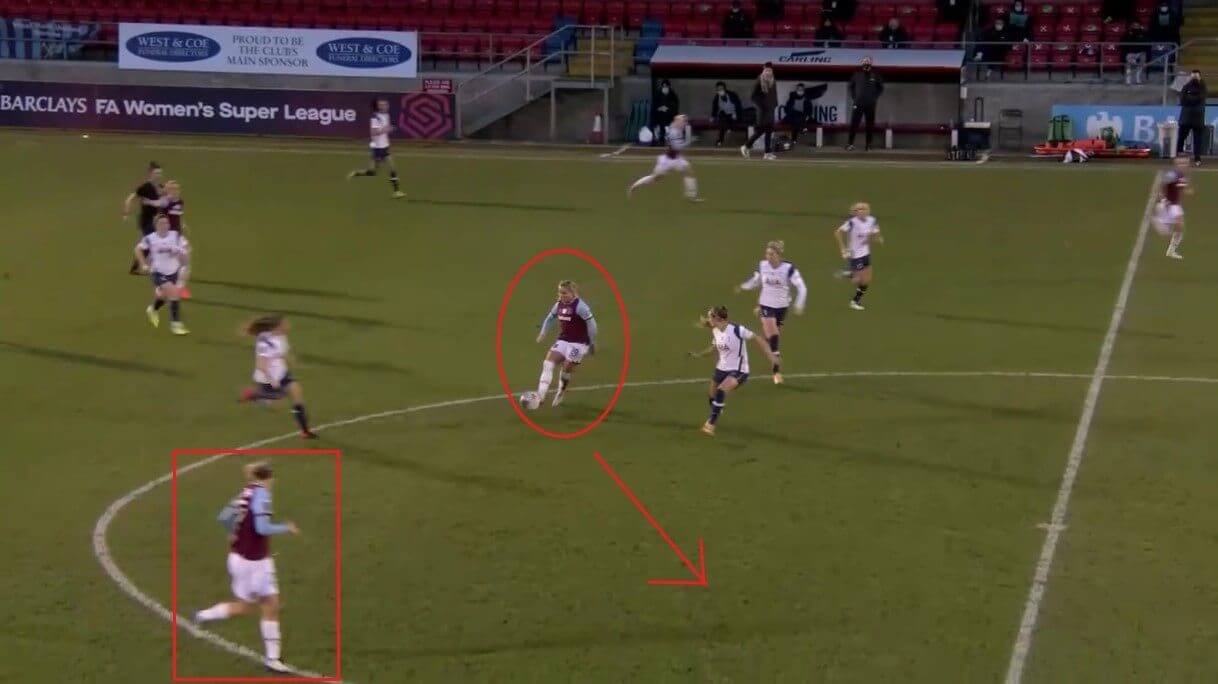
Here, we see how Leon, in the red circle, is the heartbeat of the team. Most of West Ham’s attacking play involves her in some way, often because she controls the ball and moves it forward. In this particular image, she moves it into the space for van Egmond, in the red square, to run onto, and this is why Leon’s ability to not panic under pressure from opponents is why she is such an important player for her team.
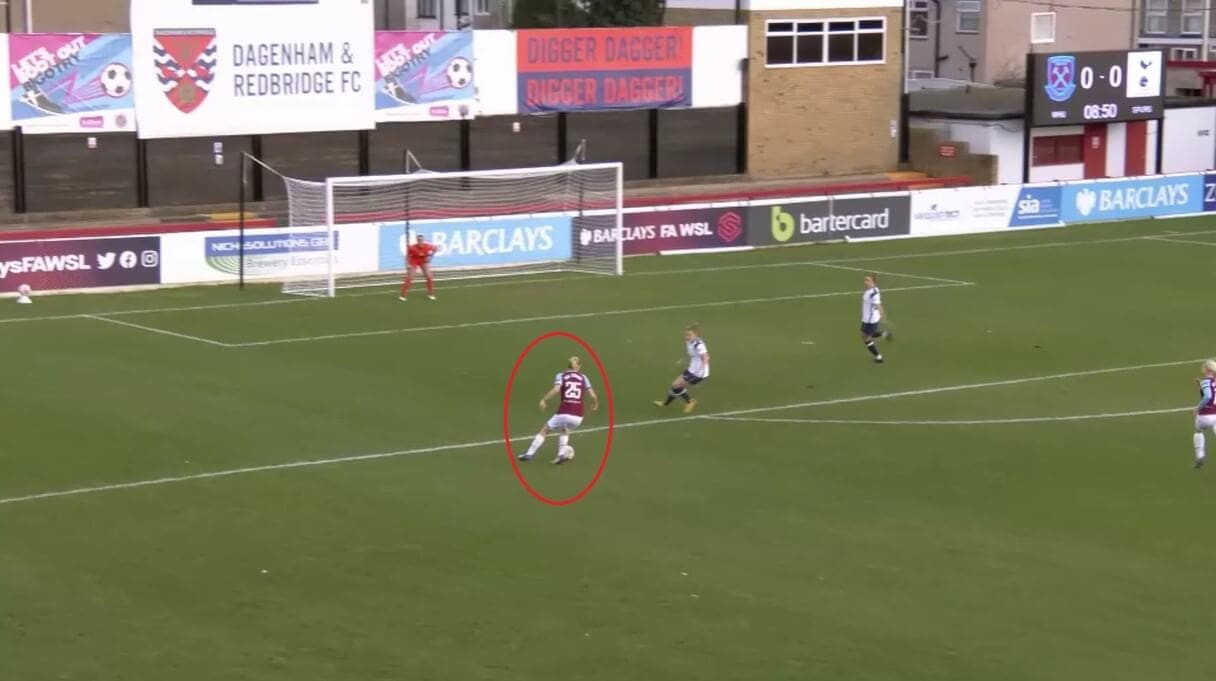
As for van Egmond, she is a quick, attack-minded midfielder, and is generally the one who gets forward and behind opposing defences. West Ham tend to play with Scotland international Martha Thomas as their central striker, but van Egmond’s pace means she is often the one playing furthest forwards. Here, we see how she has the ball just outside the box, with Tottenham Hotspur Women looking to close her down. However, as well as having pace, van Egmond also possesses skill with the ball, able to turn direction quickly, and she finds the gap in between the defenders here, shooting at goal. The fact that she gets into these positions gives West Ham a target in the final third, which is important, and is something they can build on going into the second half of the season.
Again, this comes from West Ham giving their midfielders a free role, rather than restricting them to playing in a particular area of the team.
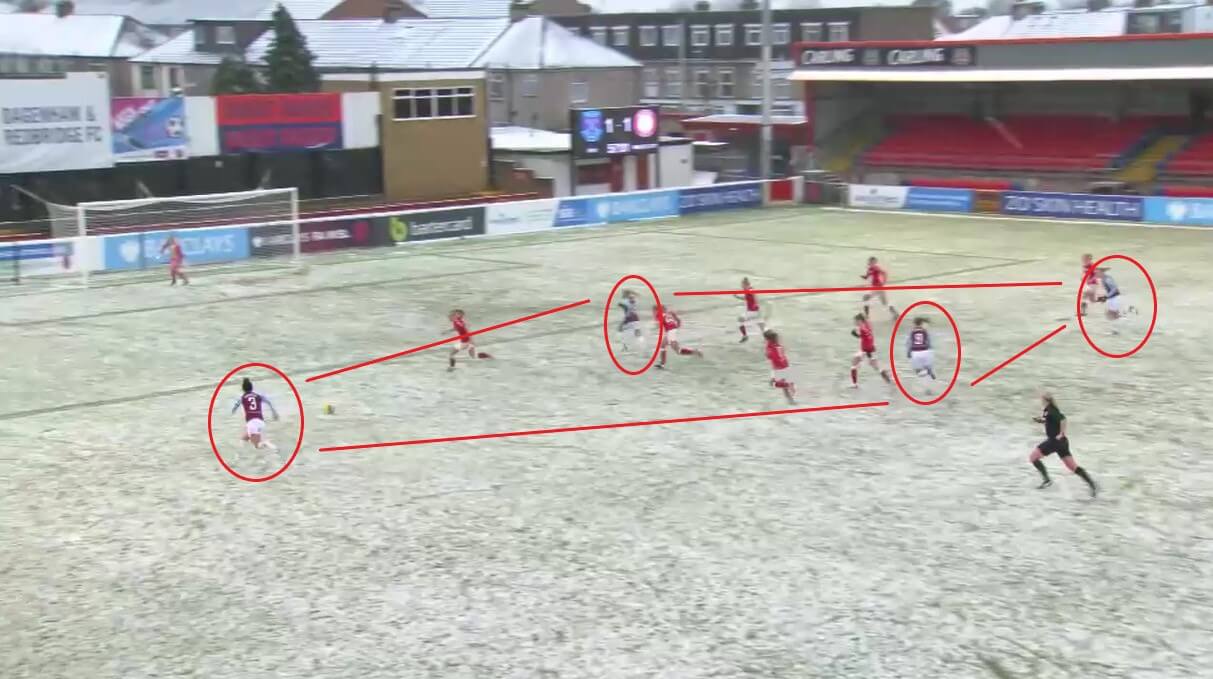
It also means that they can get into situations like this, where they flood the attack with players, stretching the opposing defence out. This season, they have changed to play with wing-backs, with Maz Pacheco and Norway international Cecilie Redisch taking up more advanced roles this season, using their pace to ask questions of opposing full-backs, and this means West Ham always have natural width in attack. Here, Pacheco, wearing number three, has joined her teammates to make this four-player attacking diamond. This increases the chances of West Ham scoring, because they can match or even outnumber the defenders, but, when that is not the case, like here against Bristol City Women, their natural width comes into play. This type of attacking play would not be possible without West Ham allowing their key midfielders to move around the pitch, acting as creative players able to transfer the ball where necessary.
Getting numbers in attack
If we now build on that aspect of West Ham United Women’s play, we will see what difference it makes when they have these numbers in attack.
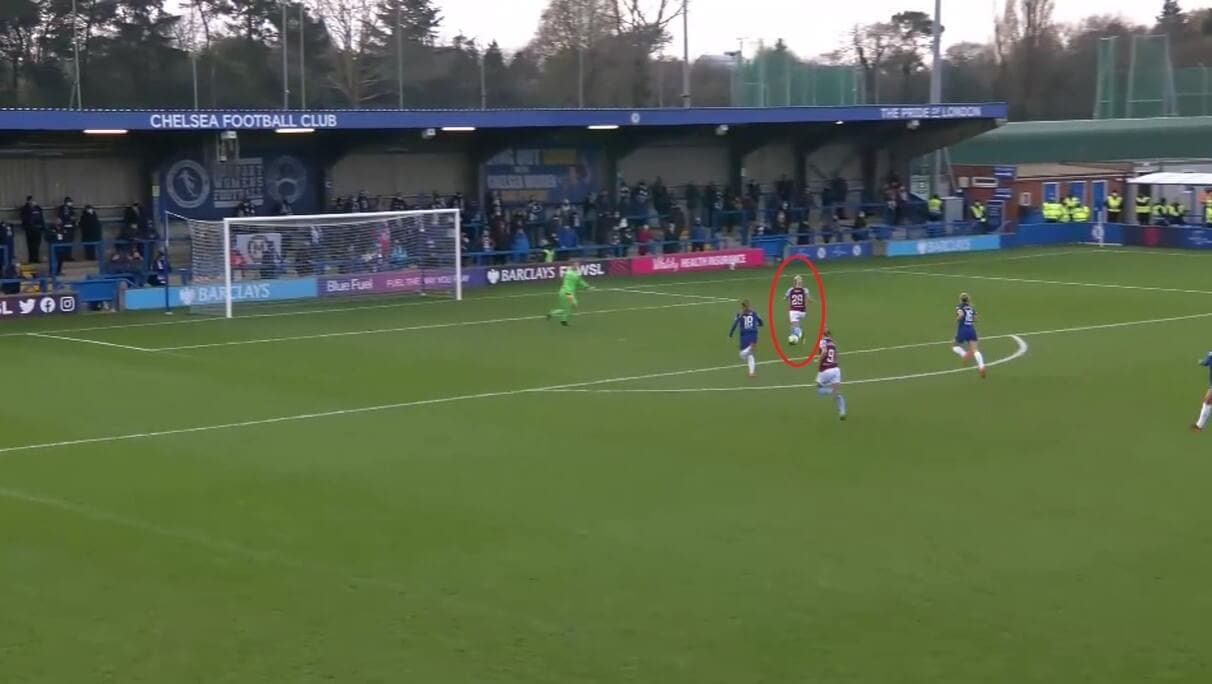
Here, we see how England winger Rachel Daly, who spent the first half of the season on loan at West Ham from NWSL side Houston Dash, has got into an advanced position, but hasn’t got the support necessary to take full advantage of the opportunity. Instead, she hesitates, shooting straight at Chelsea Women goalkeeper Ann-Katrin Berger. We can see how Daly has got behind Chelsea’s defenders, which is another key part of their play; we saw in the last section how Emily van Egmond also likes to get into these positions. This therefore again highlights how free West Ham’s attackers are to move around and position themselves in spaces, making them harder to mark up.
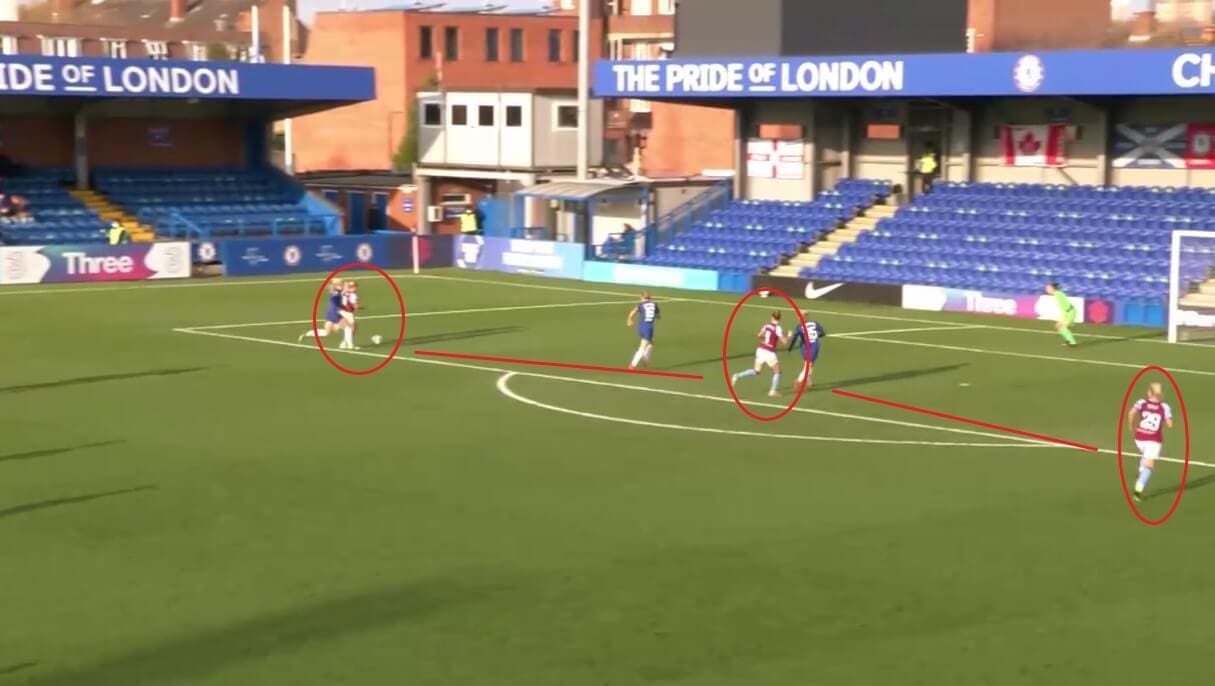
However, if we contrast Daly’s chance with this one, also coming against Chelsea, we can see how West Ham now have three players in the attacking move, working together. The ball is with the player on the far side of this attacking three, with two passing options available to her. Martha Thomas makes an attempt to get to the ball in the middle when it comes in, but she misses it. However, because West Ham have the third player, Daly, the chance doesn’t end there. The England winger instead controls the ball and puts it into the net in an easy manner.
Therefore, as we have now seen in multiple examples, West Ham have a greater chance of scoring when they get numbers forward to support the attack. This sounds like a simple thing to say, but a few teams prefer to play with a single attacker, like Birmingham City Women, and it works for them, but West Ham’s players struggle to convert opportunities when attacking alone, as we have seen. This is why their change to play with wing-backs is significant, and gives them a greater chance of scoring goals, and is something they can use to help them in their survival bid in the second half of the season.
Wing play
A key tactic that West Ham United Women use in attack is to link their wing-backs with the wide forwards, looking to outnumber their opponents in those areas, increasing their chances of keeping the ball and using the space.

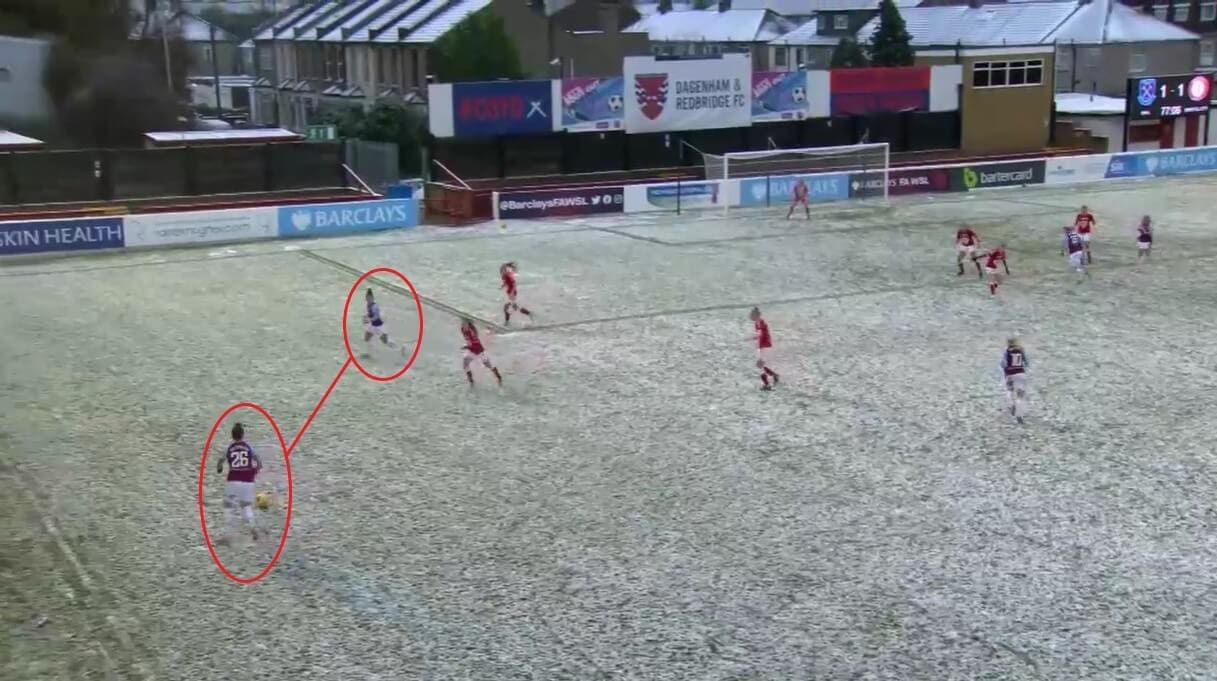
These two examples show how this occurs on both sides of the pitch, and we can see how it gives West Ham two options at any one time. If one has the ball and is closed down, they can move the ball to the other, meaning their attacks don’t break down as easily. We mentioned previously how West Ham have switched this year to play with wing-backs instead of full-backs, and this link-up between the wide players is a consequence of this.
If, in both examples, there was only one West Ham player in the space, Bristol City Women could close them down and force them to play the ball backwards with a simple two-v-one. Therefore, the second player’s presence has a vital role in making the attacks work.

The other thing that comes from this is that the two players on the edge of the back three can get forward, just like Sheffield United in the men’s game, and those players often provide balls into the box as well. Here, young England star Grace Fisk has the ball, and is in a good position to find a teammate in the box; they have lined up to run onto any ball she does put in. The number of players comes again from West Ham’s new system, which means that they can get three attackers and the wing-backs into these forward areas. This makes it harder for Bristol to defend against them here, so, again, the wing play from West Ham has been crucial to their attacking play, and is something they can keep to help them in their survival bid.
However, one negative with this is that West Ham’s crossing is not as good as it needs to be. Like with Bristol, they get into good areas of the pitch, but lack quality with the final ball at times. This means that they can’t make their chances count, despite taking up these good positions, and this is a major issue for them to sort out. This is highlighted by the fact that they have only scored 14 goals this season, so just over a goal a game on average. If they were more accurate when setting up goalscoring chances, they might find they increase their productivity in the box.
The defence
If we now look at West Ham United Women’s defence, we can see how they set up well, with a well-organised structure.
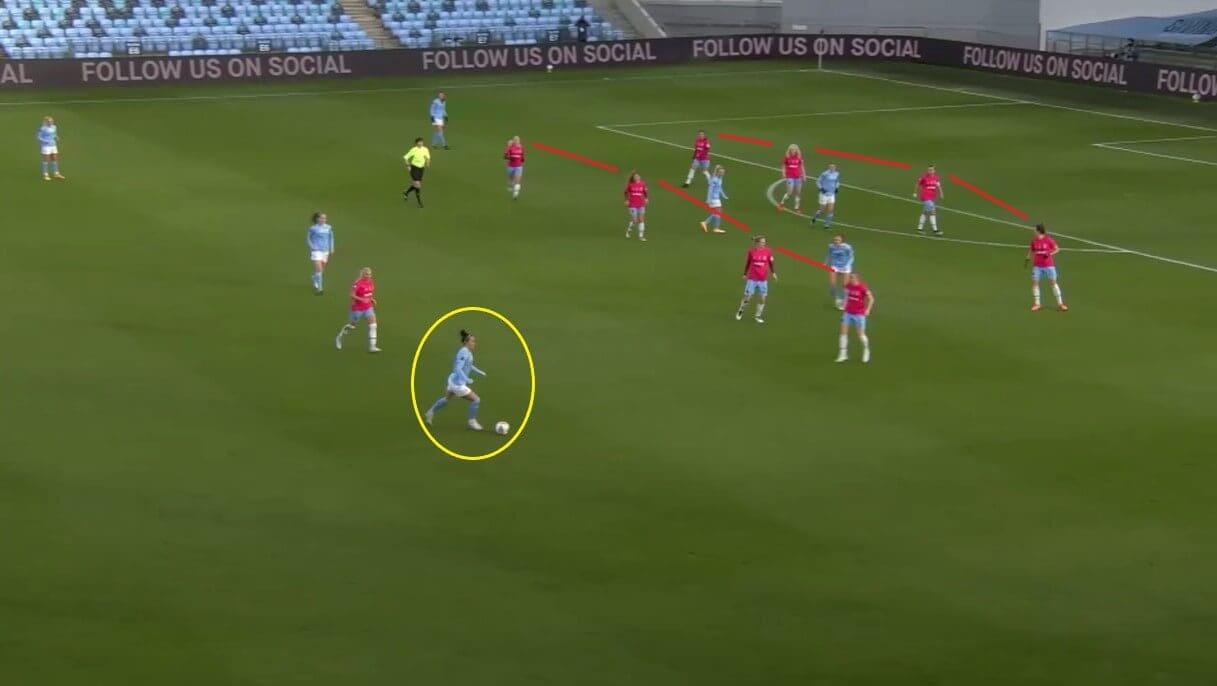
By positioning narrowly, they force their opponents to play the ball wide, making it easier to stop them getting it into the box. That happens here, as Manchester City Women right-back Lucy Bronze can’t find a teammate in the middle, and has to pass to the wing instead, as her body position shows. West Ham then look to block the cross when it is attempted from the wing, which is easier than stopping a run through the middle.
What is particularly notable about West Ham’s defence is that they can alter it, depending on where the ball is on the pitch. When it is further away from goal, they have a wide structure, stretching across the pitch. This makes it hard for their opponents to break through them, and to find the space behind. However, as the ball gets closer, West Ham become narrower, closing off the gaps between each of the players, forcing their opponents to play wide, as mentioned. This means that they are in control of every situation, which is important in their current league situation.
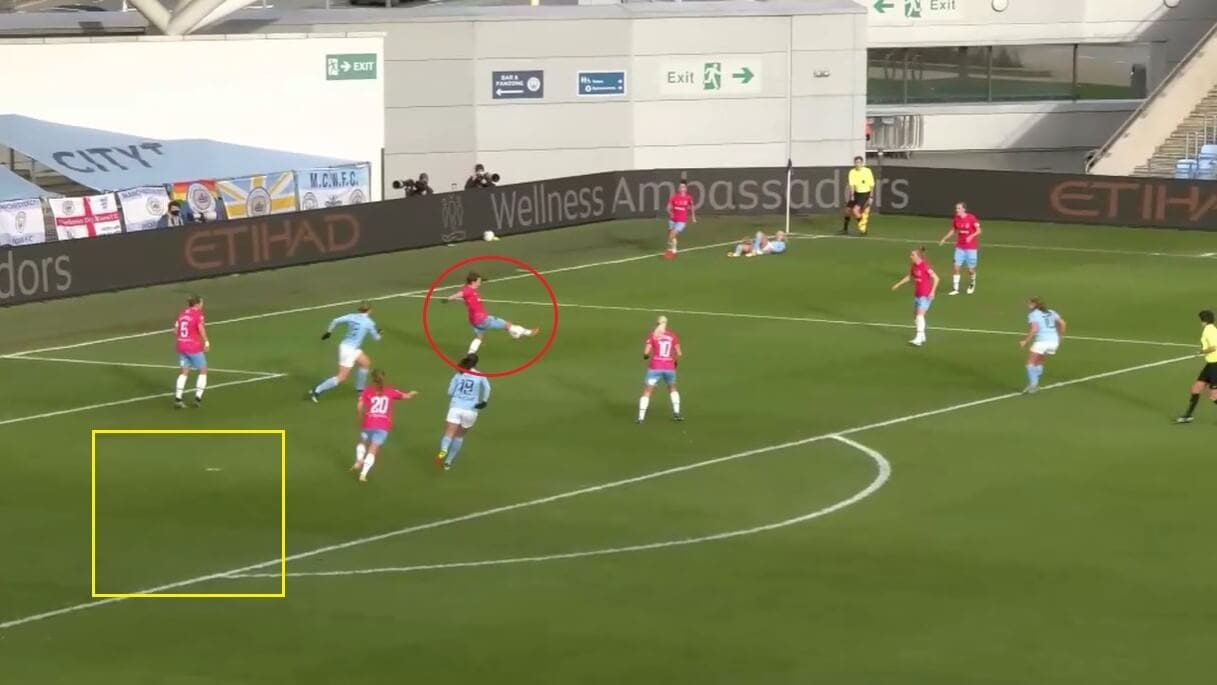
However, where their defensive tactics fall down is when their opponents get into those areas and then look to play the ball into the box. As we can see here, West Ham make too many individual mistakes, giving their opponents easy chances to score. Here, against Manchester City, the ball is travelling into the box, and the defender in the red circle has made an attempt to win it. However, she doesn’t, and it ends up in the area marked by the yellow square. From there, Caroline Weir controls it and scores, so, whilst West Ham did the right thing in forcing Manchester City towards the wing, they need to be better in the box, cutting out the passes when they come in, otherwise it is all for nothing.
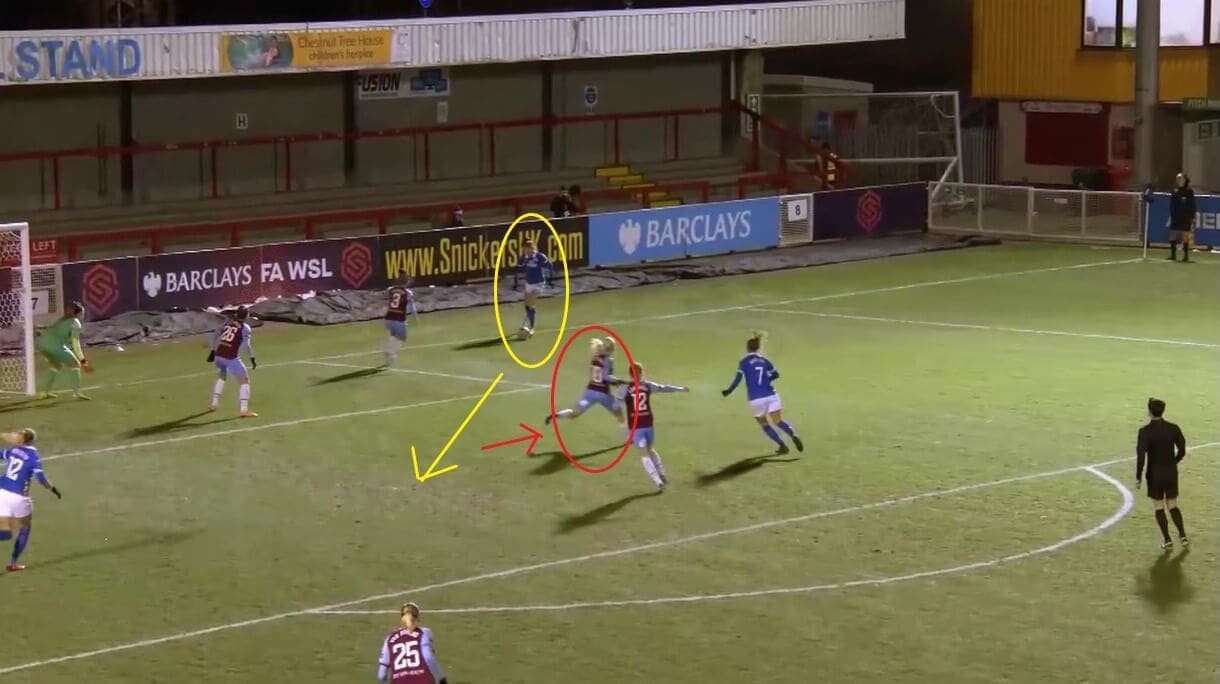
This is another example of West Ham making an error with an opposing pass into the box. Brighton and Hove Albion Women striker Ellie Brazil, in the yellow circle, has the ball outside the box, with teammates available in the middle for her to find. West Ham give her the space here, as shown by the way Czech Republic midfielder Katerina Svitkova moves away from the goal, which the red arrow illustrates, and that leaves the space open for Brazil to play the ball through the gap, as indicated by the yellow arrow, which leads to a chance for Brighton to score.
Therefore, one thing that new West Ham boss Olli Harder must work on is cutting out these passes, because that would really help them to stop conceding as many goals as they have done. Their goals against number currently reads 30, the joint-second most in the league (with Aston Villa Women), and only Bristol have let more in.
However, the other thing that happens at times is that they let opposing players run through them too easily.
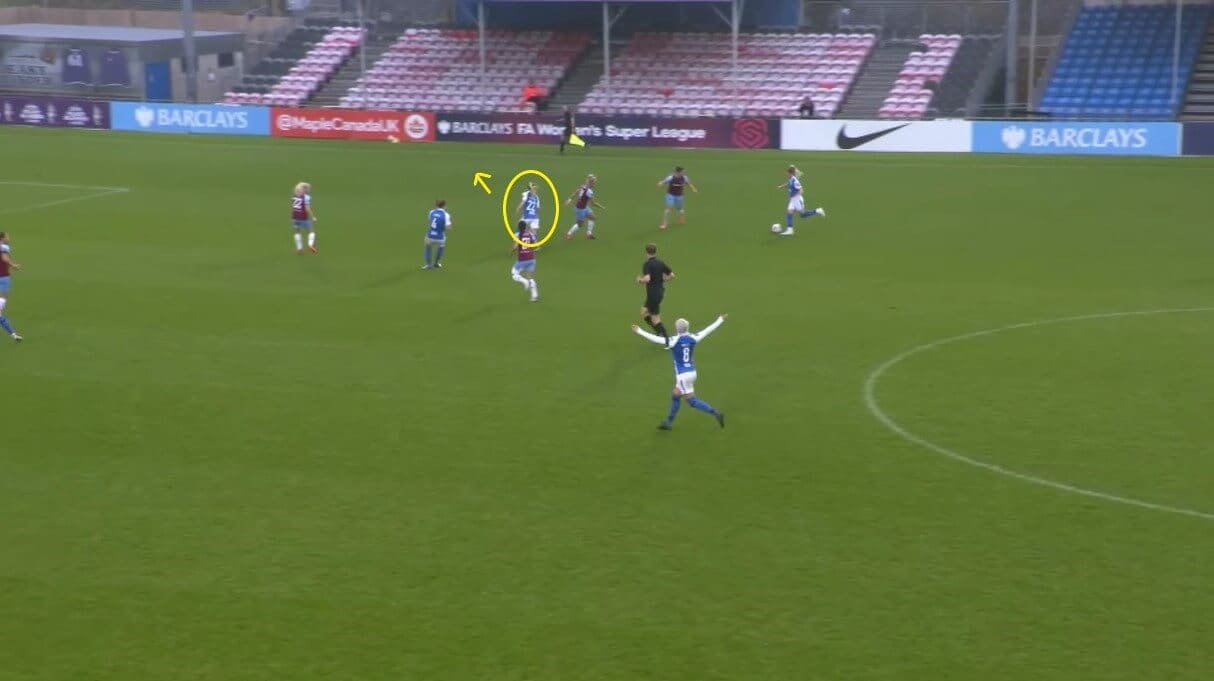
Here, Birmingham City Women midfielder Connie Scofield has found a gap in West Ham’s defence, and gets behind them before they have realised what they are doing. This is another downside of West Ham’s back five tactics; they leave gaps open on the wings when the wing-backs can’t slot in at the back. Scofield is now a viable target for Birmingham to find, and we know how they like to play the ball into those areas to shoot at goal from. West Ham have forced the ball to go to the wing, which is what they want, but there is an increased chance for Birmingham to score this time, because the narrow defence we saw previously is not there. Therefore, this is something West Ham need to watch, because, again, if they can stop opponents finding these spaces, they will not concede as many goals from easy situations.
Statistical comparison
We have looked at a number of positives and negatives for West Ham United Women this season in this analysis, but the best way to see where they can improve is by looking at their statistics for this season, compared with last season, when they finished eighth in the WSL.

Given that last season was cut short, it is not surprising that most of their values are better this season than last. However, there are a couple of interesting things to mention.
Firstly, if we look at their goals and expected goals values (xG), then we can see how, last season, they exceeded it by 0.23. This season, they are currently below their xG by 0.01, which is still good. However, whilst they have a higher average goals per game value this season, they still need to score more, otherwise they will not pull away from the bottom and survive relegation. We have looked in this analysis at how they can do this, improving their play in the final third with balls into the box, and getting numbers into the box to increase their chances of scoring when they do have the ball.
The second thing to take from this is that they have lost more aerial duels this season than last, and this again comes back to their lack of defensive strength when in the box. We have seen how they make mistakes when the ball comes in across the ground, rather than in the air, but it’s the same point that we can make; they just need to be better at blocking and clearing balls, which will help them to be harder to beat.
Conclusion
In conclusion, this analysis has looked at the positives and negatives of West Ham United Women’s play this season, looking to suggest the good points they can build on in games, and where they can improve, giving them a good chance of staying in the WSL. We have taken a comprehensive look at all areas of the team, and the points to take away are that they have a good squad, but just lack a bit of quality at both ends of the pitch. With Bristol City Women really struggling to pick up points, if West Ham can improve on those few areas we have suggested, that should be enough to see them stay in the league at the end of the season.





Comments